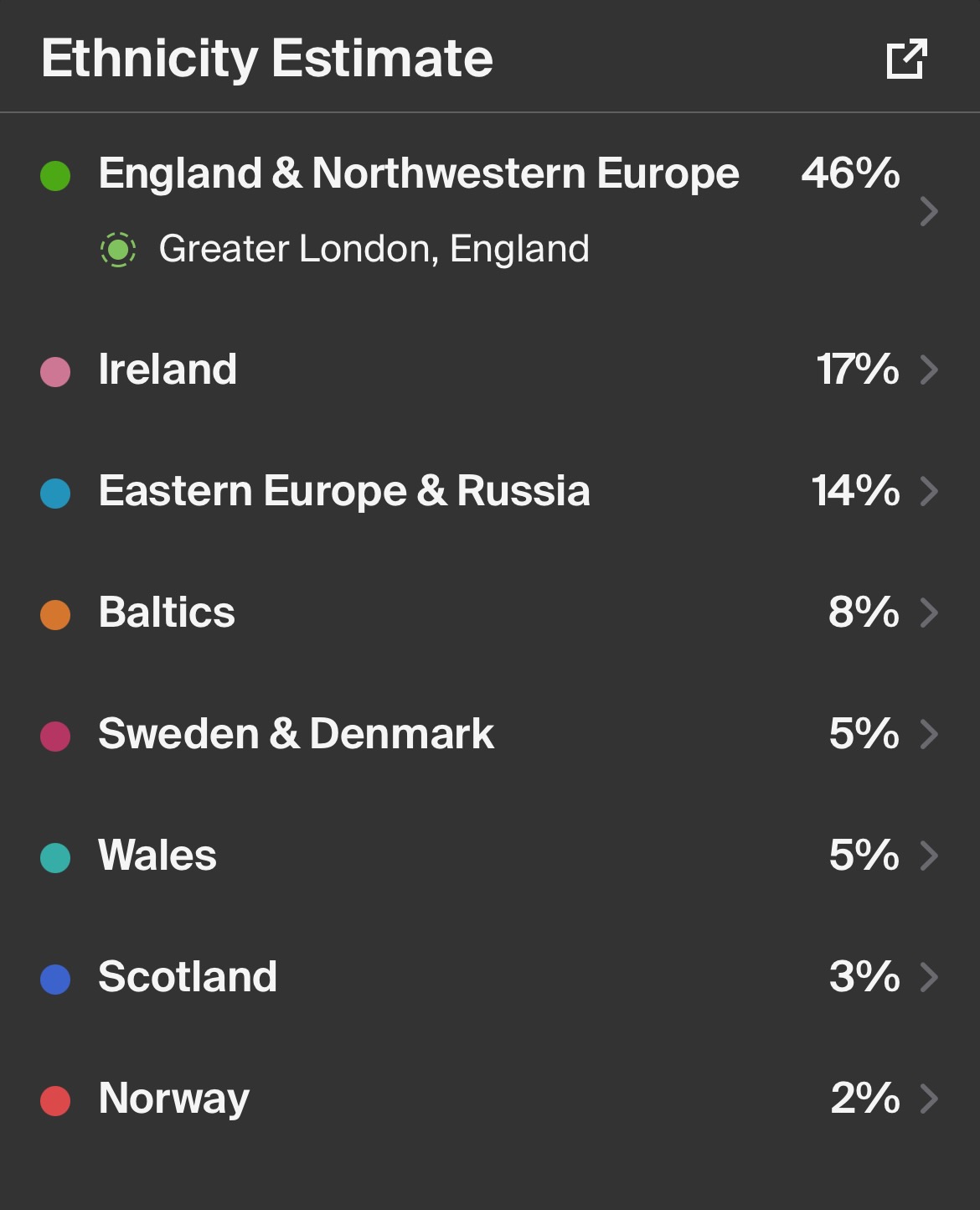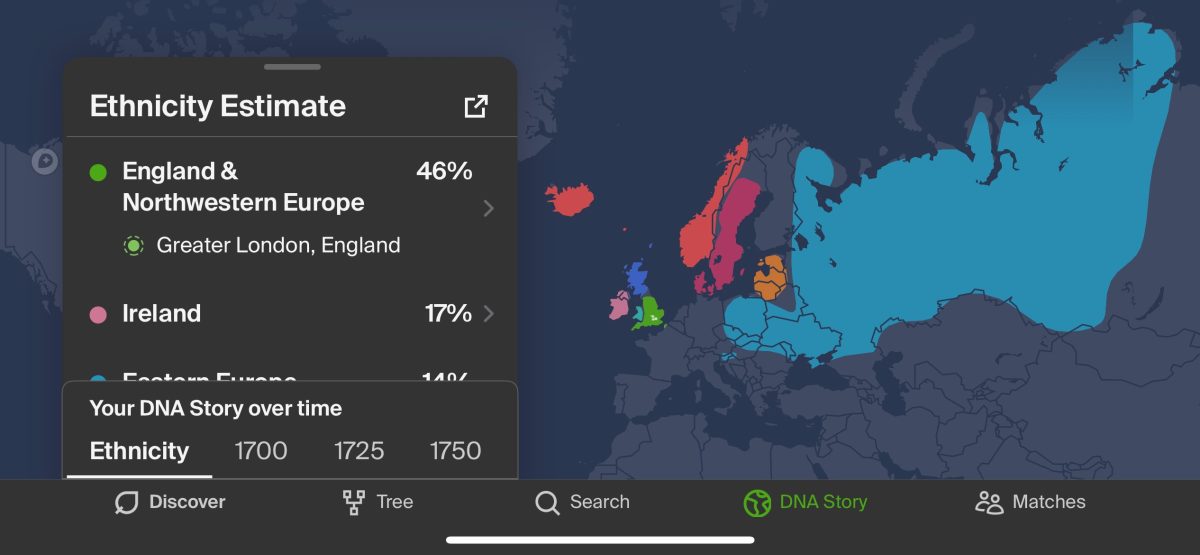This may be the final tally for my DNA. It has been refined over the years.


England & Northwestern Europe (46%)
Your DNA shows that you have ancestry from England & Northwestern Europe and links you to these specific regions:
• Greater London, England
The history of Britain, the heart of our England & Northwestern Europe region, is often presented as one group of invaders after another displacing the native population. The Romans, Anglo-Saxons, Vikings, and Normans all left their mark on Britain both politically and culturally. However, the story of Britain is far more complex. In fact, modern studies suggest the earliest populations weren’t wiped out, but adapted and absorbed the new arrivals.
Ireland (17%)
Our Ireland population region is centered on this small island famed for its emerald-green landscape, vibrant Celtic folklore, and deep-rooted spirit of hospitality. The region’s Celtic heritage is notable in its culture, landscape, and the lyrical dialects of the Irish language spoken here. The island boasts a rich sporting culture, with Gaelic football, hurling, rugby, and football, and is famous for its literary prowess as well, with names like Swift, Joyce, Yeats, O’Brien, and Rooney. After centuries of emigration, most notably during the Irish Famine (1845-1849), this island is the original home of an Irish diaspora that is estimated at over 100 million members.
Eastern Europe & Russia (14%)
Our Eastern Europe and Russia region stretches from the Baltic Sea in the north to the Adriatic in the south. The landscape is a mix of mountains, rivers, and plains and stands at the crossroads of Europe and Central Asia. By the 5th century A.D. Slavic peoples were moving west into modern-day central Europe, followed by Magyars, who settled Hungary. The Slavic peoples are now the largest linguistic and ethnic group in Europe, and the region’s legacy of beauty and civilization lives on in famed world cities such as Prague, Kyiv, Moscow, and Budapest.
Baltics (8%)
Thousands of years ago, the early ancestors of the peoples in our Baltics region came from the east and south. They entered a landscape of low-lying plains, thousands of lakes, and millions of acres of forest, a beautiful boundary zone straddling eastern and western Europe. Inhabitants have seen Vikings, crusading Teutonic Knights, empires, and Communism come and go, but they have maintained an attachment
Sweden & Denmark (5%)
Our Sweden & Denmark region emerged from glacial ice as lands of lakes and islands, mountains and plains. Though the countries were often at war, the people share a common Norse heritage that includes elements of language, religion, and art, though they eventually developed cultures of their own.
Situated along the western boundary of the Baltic Sea, relative geographic isolation did not stop the Swedes and the Danes from influencing culture, trade, and politics in Europe and around the globe.
Wales (5%)
The rolling hills and steep cliffs bounded by England to the east and 870 miles of coastline on the north, west, and south make up our Wales population region-or Cymru in Welsh, which is still spoken there. First settled by Celtic tribes, the country’s ancient and medieval history has been preserved and woven into a modern sense of Welsh identity and pride, which is still visible in the country’s 600 castles, its Welsh-language media, and its Eistedfoddau, festivals that celebrate Wales’s long tradition of literature, poetry, and music.
Scotland (3%)
With its center in the northern third of the island of Great Britain but stretching down to Brittany in France, our Scotland ethnicity region is known for its geographical beauty, medieval arenitecture, and folklore. Gaelic and Scots have influenced regional English dialects and are both still spoken in some areas. National symbols, including the Lion Rampant, clan tartans, and bagpipes, are often recognized internationally alongside symbols of traditional cuisine, like whisky and haggis.
Norway (2%)
The earliest inhabitants of our Norway region were strong, seafaring peoples. For centuries, hunter-gatherers slowly pushed north across the Baltic Sea, probing coastal fords and inland stretches for arable land as ice melted off the untamed region. While Norwegians, Swedes, and Danes all share a common Norse heritage, over time, Norway’s resilient coastal communities evolved into a nation known for its seamanship, technology, artistry, and mythology.
My take
I am exclusively Western European and some Eastern European My paternall Grandfather was from Poland by way of England. My paternal Grandmother was from England and my dad was born in Greater London Area. My grandparents, my dad and one of my uncles immigrated to the US in the 1950’s. My dad was 6 years old. So that all makes sense.
My Maternal Grandparents were Irish and Wales for sure. But I knew I was a big ole mutt. That side of the family goes much further back than just my grandparents. I am working on the Ancestry app to help figure things out, but I am cheap and don’t want to pay for it, so the free stuff is limited in scope.
All in all, it is pretty cool to see where my ancestry lies.
